Are you seeing a 500 internal server error in WordPress?
The internal server error is one of the most common WordPress errors.
It is a bit tricky because the error doesn’t give any other information, many beginners find it quite frustrating.
In this article, we will show you how to easily fix the 500 internal server error in WordPress.
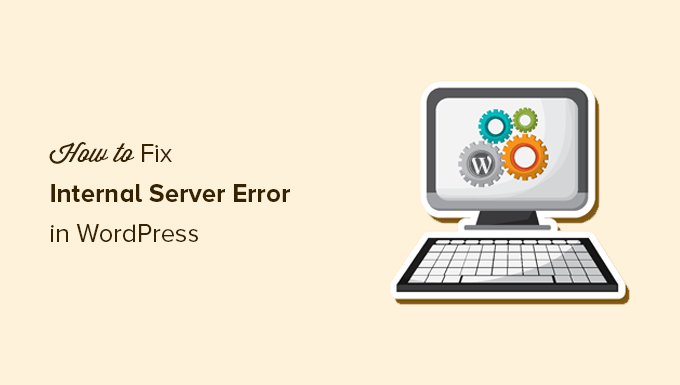
Here is a quick overview of the topics we will cover in this article:
- What Is the 500 Internal Server Error?
- What Causes the Internal Server Error in WordPress?
- Fixing the 500 Internal Server Error in WordPress
- Clear WordPress and Browser Cache
- Checking for Corrupt .htaccess File
- Increasing the PHP Memory Limit
- Deactivate All WordPress Plugins
- Switch to a Default WordPress Theme
- Re-Uploading Core Files
- Enable Debug Logs in WordPress
- Ask Your Hosting Provider
What Is the 500 Internal Server Error?
The 500 internal server error is a common web server error. It is not specific to WordPress and can happen with any website.
The 500 in the error message is technically an HTTP error code. Looking up this code will only show its standard description:
“500 Internal Server Error response code indicates that the server encountered an unexpected condition that prevented it from fulfilling the request.“
This is a generic catch-all error message, which means that the server was unable to assign a better, more helpful error message when it encountered the issue.
The error page looks different depending on which web server software (Nginx or Apache) your website uses and which browser you use.
Here is how the Apache error page may look:
It may look different if you are using Nginx and Google Chrome.
It will also look different if Google Chrome is unable to find an error page to display:
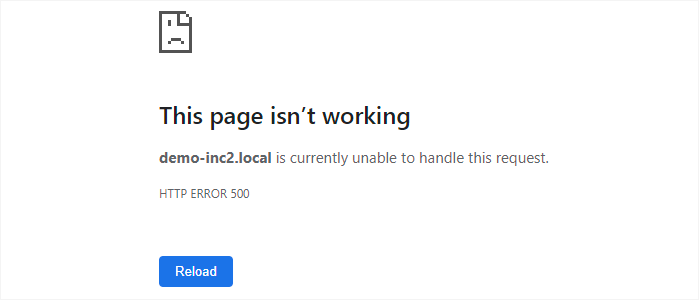
For beginners, this can be incredibly frustrating. No clue or message will point them in the right direction to quickly fix it.
Asking how to fix an internal server error is like asking your doctor how to fix the pain you are experiencing without telling them where the pain is.
However, if you know the common causes that trigger this error, then you can try fixing them one by one to resolve the error without breaking anything.
What Causes the Internal Server Error in WordPress?
Internal server error in WordPress is often caused by a corrupt .htaccess file, poorly coded plugins, or your active WordPress theme.
Other possible causes of the internal server error in WordPress are PHP memory limit or corrupt core WordPress files.
In some conditions, the internal server error may only show up when you are trying to access the WordPress admin area while the rest of the site works fine.
Usually, the error is triggered before WordPress can load and the server cannot get enough information about what stopped it.
To understand more, see our article on how WordPress works behind the scenes.
That being said, now let’s take a look at how to go about troubleshooting the internal server error in WordPress.
Video Tutorial
If you prefer written instructions, then just continue reading.
Fixing the 500 Internal Server Error in WordPress
Before you begin troubleshooting, make sure that you have a complete WordPress backup of your website on hand.
If you have access to the WordPress admin area, then you can use a WordPress backup plugin to create a complete backup of your website.
We recommend using Duplicator to handle this. It not only helps you quickly back up your website, but you can also store your backups on the cloud, and most importantly, you can restore your website from backup.
On the other hand, if you don’t have access to the WordPress admin area, then you can manually create a WordPress backup using phpMyAdmin and an FTP client.
After that, you can follow the following steps to troubleshoot and fix the internal server error on your website.
Clear WordPress and Browser Cache
Browsers and your WordPress caching plugins can sometimes mistakenly store a cached copy of an error page.
The easiest way to fix this is by first clearing your browser cache.
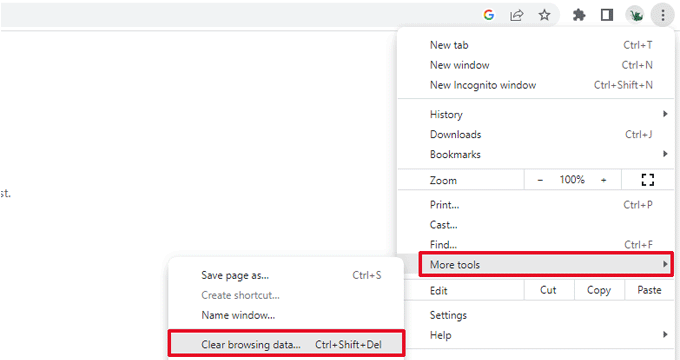
After that, if you have access to the WordPress admin area of your website, then you can empty the WordPress cache by visiting your caching plugin’s settings page.
For details, see our tutorial on how to clear WordPress cache.
Checking for Corrupt .htaccess File
The .htaccess file is a server configuration file that is also used by WordPress to set up redirects.
One of the most common causes of the internal server error is the corrupt .htaccess file.
The easiest way to fix this is by simply visiting the Settings » Permalinks page in the WordPress admin area and then clicking on the ‘Save Changes’ button without making any changes at all.
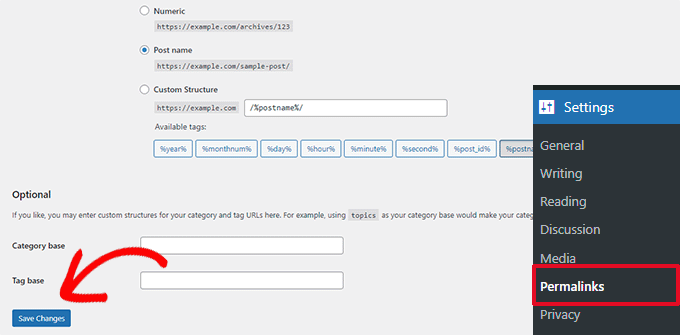
WordPress will now try to update your .htaccess file or generate a new one for you. You can now visit your website to see if this has resolved the internal server error.
If you can still see the error, then you need to make sure that WordPress was able to generate or write to the .htaccess file.
Sometimes, due to file and directory permissions, WordPress may not be able to create or write to your .htaccess file.
You can now try to replace the .htaccess file manually. First, you need to log in to your website using FTP or the File Manager app under your hosting account control panel.
Next, you need to rename your main .htaccess file to something like .htaccess_old. This lets you keep the file as a backup, but WordPress won’t recognize it.
To rename the .htaccess file, you will need to log in to your site using FTP or the File Manager app in your hosting account’s cPanel dashboard.
Once you are connected, the .htaccess file will be located in the same directory where you will see folders like wp-content, wp-admin, and wp-includes.
Simply right-click on the .htaccess file and rename it to .htaccess_old.
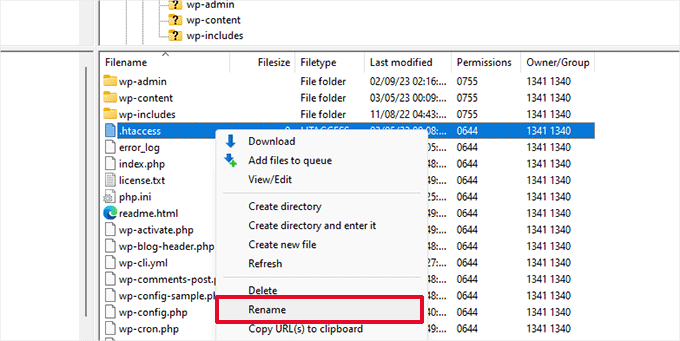
Next, you need to create a new .htaccess file.
Inside your site’s root folder, right-click and then select the ‘Create new file’ option in your FTP client or File Manager app.
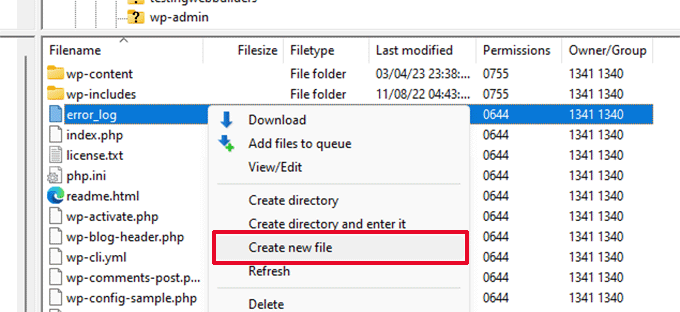
Name this new file .htaccess and click ‘OK’ to save it.
Now, this .htaccess file is currently empty, and you need to add default WordPress rewrite rules to it.
Simply right-click on the file and then select ‘View/Edit’ in your FTP client or File Manager app.
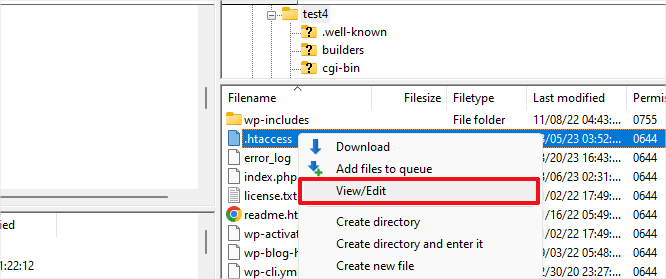
The empty file will open in a plain text editor like Notepad or TextEdit.
Now, you need to copy and paste the following code inside it:
# BEGIN WordPress
<IfModule mod_rewrite.c>
RewriteEngine On
RewriteBase /
RewriteRule ^index.php$ - [L]
RewriteCond %{REQUEST_FILENAME} !-f
RewriteCond %{REQUEST_FILENAME} !-d
RewriteRule . /index.php [L]
</IfModule>
# END WordPress
This code is the default rule set used by WordPress. Don’t forget to save your changes and upload the file back to the server.
You can now visit your website to see if this has resolved the internal server error.
If it did, then give yourself a pat on the back because you fixed the internal server error.
Important: Before you move on with other things, make sure that you go to the Settings » Permalinks page in the WordPress admin area and click the Save button without making any changes. This will regenerate the .htaccess file for you with proper rewrite rules to ensure that your post pages do not return a 404 error.
If checking for the corrupt .htaccess file solution did not work for you, then you need to continue reading this article.
Increasing the PHP Memory Limit
Sometimes, the internal server error can happen if a script consumes all the PHP memory limit.
The easiest way to increase the PHP memory limit is by editing the wp-config.php file. Be careful when you do this if you are a beginner. You want to follow these instructions carefully because even small mistakes in WordPress core files can break your site.
To begin, simply connect to your WordPress website using an FTP client or the File Manager app under your hosting account control panel.
You’ll find the wp-config.php file inside the main folder of your website. Right-click on it and select ‘Download.’ This will ensure that you have a file backup in case something goes wrong.
When you’ve saved that, you can right-click on it and select ‘View/Edit.’
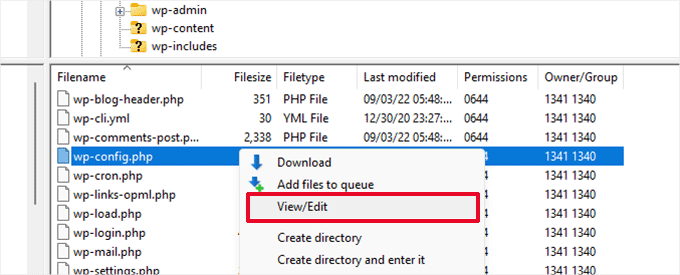
Inside the wp-config.php file, you need to add the following code just above the line that reads, ‘That’s all, stop editing! Happy publishing’:
define( 'WP_MEMORY_LIMIT', '256M' );
For more details, see our tutorial on how to increase the PHP memory limit in WordPress.
Note: If 256M doesn’t solve the problem, then try increasing it to 512M.
If you see the internal server error only when you try to log in to your WordPress admin or upload an image in your wp-admin, then you should increase the memory limit by following these steps:
- Create a blank text file on your computer and name it php.ini
- Paste this code in there: memory=256MB
- Save the file
- Upload it into your /wp-admin/ folder using FTP
If increasing the memory limit fixed the problem for you, then you have only fixed the problem temporarily. You still need to find the cause that is exhausting your memory limit.
This could be a poorly coded plugin or even a theme function. We strongly recommend that you ask your WordPress web hosting company to look into the server logs to help you find the exact diagnostics.
If increasing the PHP memory limit did not fix the issue for you, you are in for more troubleshooting.
Deactivate All WordPress Plugins
If none of the above solutions worked for you, then this error is most likely being caused by a specific plugin installed on your website.
It is also possible that it is a combination of plugins that are not playing nice with each other.
If you can access the WordPress admin area of your website, then you can simply go to the plugins page and deactivate all WordPress plugins.
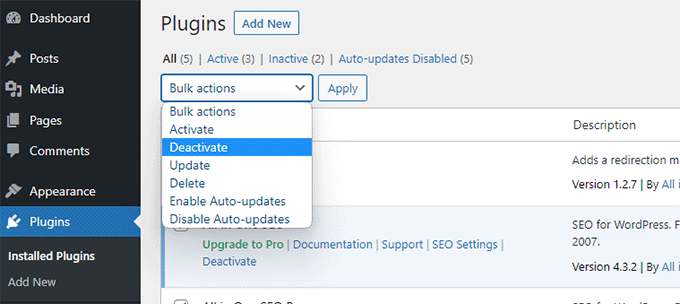
However, if you are unable to access the WordPress admin area, then you can deactivate all WordPress plugins using FTP.
Simply connect to your WordPress website using an FTP client or the file manager app under your hosting account control panel.
Once connected, navigate to the /wp-content/ folder and rename the plugins folder to plugins.deactivated.
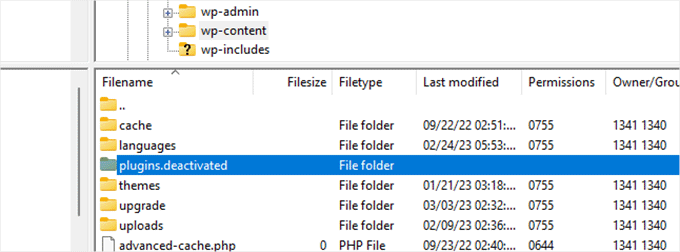
WordPress looks for plugins in the plugins folder. If the plugins folder is not found, it will automatically deactivate all plugins.
You can now try visiting your website to see if this resolved the internal server error on your website.
To restore all your plugins, you can simply rename the ‘plugins.deactivated’ folder back to plugins.
Your plugins will now be restored, but they will still be deactivated.
You can now activate plugins individually and visit your website to figure out which plugin is causing the internal server error.
For more details, see our guide on how to deactivate all WordPress plugins without WP-Admin.
If deactivating all plugins didn’t fix the internal server error on your website, then continue reading.
Switch to a Default WordPress Theme
One possible cause of the internal server error could be some code in your WordPress theme.
To determine if this is the case, you need to switch your theme to a default WordPress theme.
If you have access to the WordPress admin area, then go to the Appearance » Themes page. If you have a default theme already installed, then you can simply click on the Activate button to switch the theme.
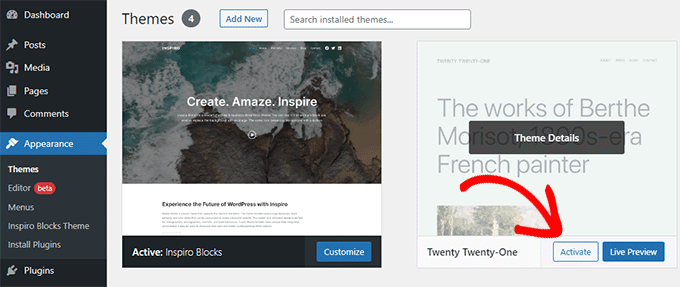
If you don’t have a default theme installed, you can click on the ‘Add New’ button at the top and install a default theme (Twenty Twenty-Three, Twenty Twenty-Two, and so on).
If you don’t have access to the WordPress admin area, you can still switch to a default theme.
Simply connect to your WordPress website using an FTP client and navigate to the /wp-content/ folder.
Right-click to select the themes folder and download it to your computer as a backup.
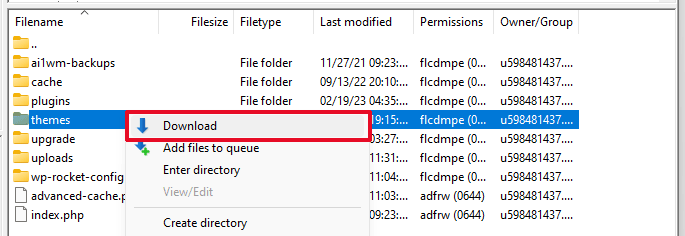
Next, you need to delete the themes folder from your website. Once it is deleted, go ahead and create a new themes folder.
Your new themes folder will be completely empty, which means you don’t have any WordPress themes installed at the moment.
Next, you need to visit the WordPress themes directory and download a default WordPress theme to your computer.
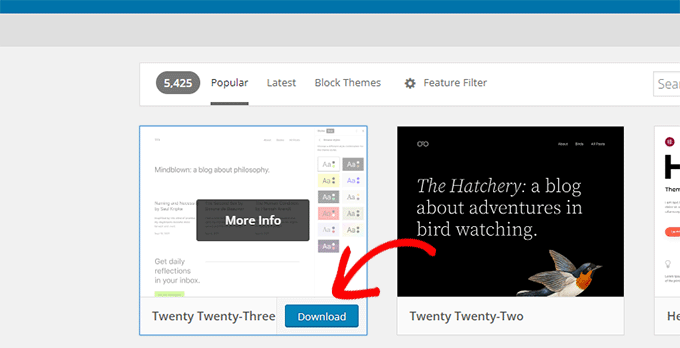
Your browser will then download the theme as a zip file to your computer.
Locate the file on your computer and then unzip it. Windows users can unzip the file by right-clicking on it and then selecting ‘Extract All’. Mac users can double-click on the zip file to extract it.
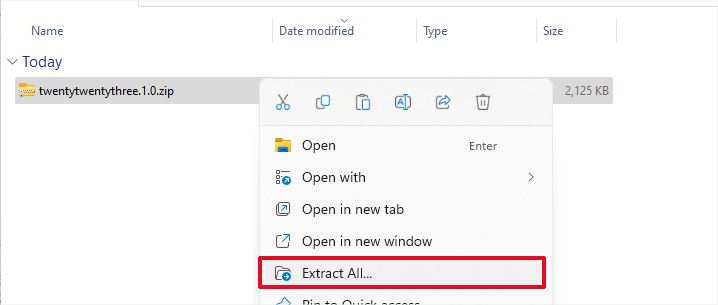
You’ll now see a folder containing your WordPress theme.
Switch back to your FTP client or File Manager up and upload this folder to the empty themes folder.
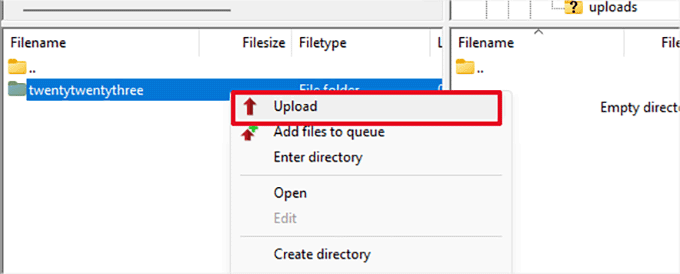
Once uploaded, WordPress will automatically start using the default theme.
You can now visit your website to see if this resolved the internal server error.
If this doesn’t work, then you can reupload your WordPress themes from the backup or switch back to the theme you were using.
Don’t worry. There are still a few more things you can do to fix the error.
Re-Uploading Core Files
If the plugin and theme options didn’t fix the internal server error, then it is worth re-uploading the /wp-admin/ and /wp-includes/ folders from a fresh WordPress install.
This will NOT remove any of your information, but it may solve the problem in case any file is corrupted.
First, you will need to visit the WordPress.org website and click on the ‘Download’ button.
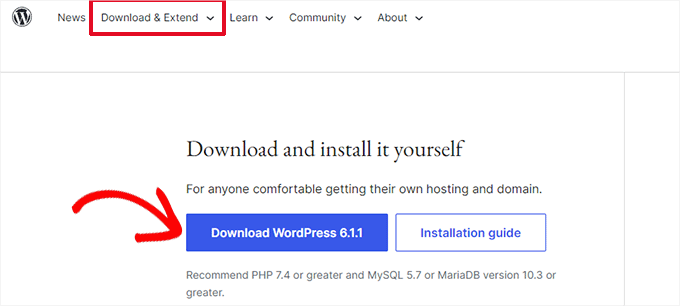
This will download the WordPress zip file to your computer.
Go ahead and extract the zip file. Inside it, you will find a wordpress folder.

Next, you need to connect to your WordPress website using an FTP client.
Once connected, go to the root folder of your website. It is the folder that has the wp-admin, wp-includes, and wp-content folders inside it.
In the left column, open the WordPress folder on your computer.
Now you need to select all files inside the wordpress folder and upload them to your website.
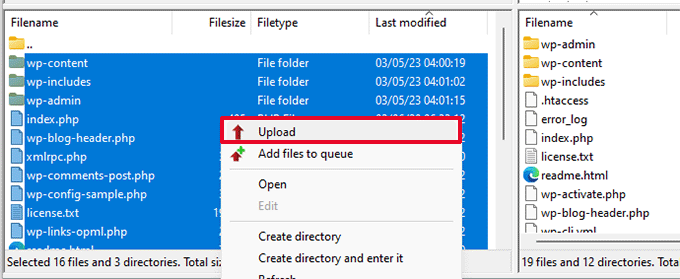
Your FTP client will now transfer those folders to your server.
It will ask you whether you would like to overwrite the files. Select ‘Overwrite’, then select ‘Always use this action’ and check the ‘Apply to current queue only’ checkbox.
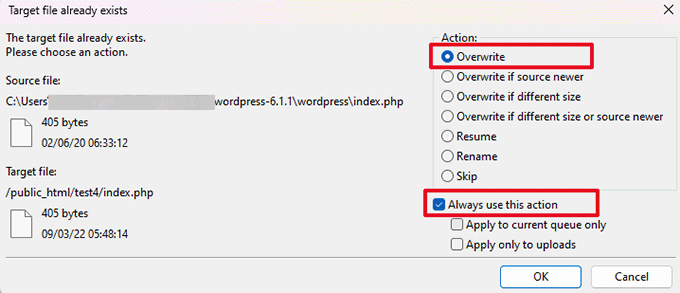
Your FTP client will now replace your older WordPress files with new, fresh copies.
If your WordPress files were corrupted, then this step will fix the internal server error for you.
Enable Debug Logs in WordPress
WordPress comes with a built-in system to keep logs for debugging.
You can turn it on by using the WP Debugging plugin. For more details, see our guide on how to install a WordPress plugin.
Once activated, the plugin will turn on debugging logs on your WordPress website.
If you don’t have access to the admin area of your WordPress website, then you can turn on debugging by adding the following code to your wp-config.php file:
define( 'WP_DEBUG', true);
define( 'WP_DEBUG_LOG', true);
Once you have turned on debug logs, you can view these logs by using an FTP client and navigating to the /wp-content/ folder.
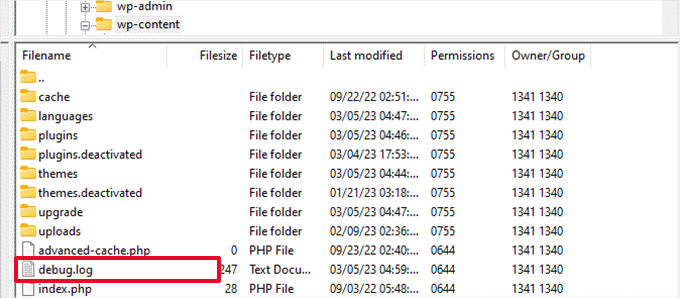
You can open the debug log file in a text editor, and it will show you a list of errors and warnings that occur on your website.
Some errors and warnings can be harmless incidents that may not need fixing. However, if you are seeing an internal server error on your website, then these may point you in the right direction.
Ask Your Hosting Provider
If all methods fail to fix the internal server error on your website, then it is time to get some more help.
Contact your web hosting support team, and they will be able to check the server logs and locate the root cause of the error.
If you want to continue troubleshooting on your own, then see our ultimate WordPress troubleshooting guide for beginners.
We hope this article helped you fix the internal server error in WordPress. You may also want to see our complete list of the most common WordPress errors and our guide on how to choose the best web hosting provider.
If you liked this article, then please subscribe to our YouTube Channel for WordPress video tutorials. You can also find us on Twitter and Facebook.





Syed Balkhi says
Hey WPBeginner readers,
Did you know you can win exciting prizes by commenting on WPBeginner?
Every month, our top blog commenters will win HUGE rewards, including premium WordPress plugin licenses and cash prizes.
You can get more details about the contest from here.
Start sharing your thoughts below to stand a chance to win!
krzysiek says
in my case it was simple although i spend few hours… I typed wrong sql server. Suprisingly it didn’t throw window with wrong config settings.
WPBeginner Staff says
You can download the old .htaccess file to your computer as backup.
Ronaldo says
Hi!
Thanks for this information. I renamed the .htaccess and my sites are up and running. My server is godaddy.
My question is, can I erase the old renamed .htaccess , because I called many times to godaddy to fix this kind of 500 internal error after many callings ?
Thanks
brooke says
thank you! that just saved the day when I made the .htaccess ftp change. i can breathe again… ; D
itechaleart says
i am facing this 500 error to last 15 days on godaddy hosting. i have tried everything what ever you mention here but not able to solve this error and also called godaddy for help, he said site are working fine on our site you check in different system.
Now feeling hopeless and thinking to move another hosting provider…
plz help me and suggest me for better option for hosting.
Thank you.
Silvia says
Hello
i had the same problem with my website and went through all
your advices, without solving it. At the end i contacted my host and
they checked things for me, finding that some folders in the FTP had
CHMOD permissions different from 775. I didn’t do anything to cause
that, it just happened one day and i can’t get why. Anyway they fixed
the problem for me and said it’s easily manageable with ftp clients or
via their own file manager.
Just hoping it may be useful
pun says
My prob is solve, thank you for this tutorial, thank you sooo much
Arun says
Hi, I’m a non-techie and a newbie… Had this issue of Internal server error last week. It all began with my admin access getting restricted. But the site was working well. Sat through this with the Hosting provider (GoDaddy) for more than 4.5 hours through the night with 3 different personnel.(This was the 3rd time over a period of 4 days or so) They were helpful to a certain extent and identified the problem (wp-admin folder was missing). They emphasized that I should have deleted it as they did not have access(Just 2 days back they changed the files for me!!). I was logging in after a periodof 7 or 8 months of setting up the site. Anyways, I asked if they could restore the folder to a previous date. They denied. The solution given was a fee of $150, where they will “try” to find out the file changes etc, but with no guarentee. (While reading the above, I assume they should have used the above content as the questions/instructions were in the above written order).
Anyways, from one of the discussions (forgot the site), I found that if the wp-admin folder(of the version installed) is put in, it should solve. Yes, it did work for me… I activated all my plugins(they had deactivated it) and the site was working. I also updated all the plugins and themes that i was using/trying. the site is up and running!
deemyboy says
@Levent Ultanur
One of the reason’s that some people might be getting an error with .htaccess and not with images is because they might be uploading it as a binary.
In Filezilla (at least) you can set the transfer type in the Transfer menu tab to:
auto
binary
ascii
I’m not certain but “auto” should usually work fine but it you’re only uploading text then maybe switch to “ascii” for that upload session, but remember to switch back again.
I never knew about this till yesterday when all the images on my site were being corrupted when I downloaded them to local. So I googled and found a post mentioning transfer type “binary” for images, but when I checked I found the transfer type was set to “ascii” (for text – I don’t know how as I don’t remember touching it!!) So I switched it to “binary” and my images came down perfectly as before.
The reason I say that “auto” is fine is because I’ve up and downloaded complete sites with a mixture of images (png, jpeg, gif etc) and text files (.php, .html, .css) and never had to set each transfer type individually or set it to “ascii” and upload only text files, then switch to binary and upload only images – Filezilla handles it all automatically…normally!
In fact I was totally unaware of this setting and I’ve been using Filezilla for around 2 or 3 years!
That MIGHT be the problem so get your clients to check the transfer type on their ftp application
I hope it helps!
deemyboy says
You have not emphasised STRONGLY enough in the solution which replaces the WordPress core that people should
a) backup the wp-content folder <— this is your website (plus the wp database which doesn't come into this as it should be unnaffected by replacing the core)
b) make sure when they replace wp-admin and wp-includes they do not grab all 3 folders (ie. do NOT include wp-content) when uploading the new core
Henrique says
Thank you very much!
Deepanshu Kakkar says
Thanks
Basha says
Very Very Useful Article…Thank..you so much
Guan says
500 internal server error after activated wordpress plugins
Warix says
Thank you so much, it was problem in plugins
Kristian Frisk says
Thanks for this post. Learned (the bitter way) how much grief a bad plugin can cause to a wordpress site.
F. Parisis says
Thank you very very very much! That was the best and only place where I found solution, after a day’s search on the web.
Tom Grant says
Good job-massive help!
Anurag says
A Big THUMBS up to this tutorial
Md.Zelal Hossain says
Thank you so much for the nice tutorial..!!!!
Mulyadi Subali says
you’ve just saved my day. thanks!
imam says
Ok thanks
Levent Ultanur says
Hey guys n girls…
What i dont get with this error is that i CAN upload images without getting the http error but My client gets the error… Same server, same files… Why ooo why… Anybody?
Kyle Hunzinger says
Thank you it was the PHP Memory Limit!
Uwe says
Thank you very much! The .htaccess was the reason!
Mark C. says
Hi, guys. Awesome post! I use this page every time I get an Internal Server error.
I would offer an additional step, however. Actually, this should be the very first step before anything else is done. That is to verify there is not a problem with the web host.
I went through all the usual steps this morning on a client’s site that went down an hour ago only to find, quite by chance, that PHP was not working on the host. A quick check of the service bulletins on the web host’s website indicated a problem had occurred with that particular server. So, all we can do is wait until they fix it. (there are other tricks like changing the A record to a different server, but that’s only if the server issue is long term.)
That said, other parts of the server are still functioning so a quick and dirty index.html was created just so visitors see something nice instead of an error.
It’s also handy to create a “test.php” file that demonstrates if PHP is working or not, and then try to access that file every so often. When service is restored, delete or rename the index.html so that the index.php will load instead.
Here is my test.php code:
PHP Test
<?php echo ‘<p>Hello World</p>’; ?>
I sure hope this helps someone in a similar boat. All the best.
Bwana says
Thanks for your help! My site only exhibited the “500 Internal Server Error” when I tried to see what plugins were installed. Naturally, I figured there was a misbehaving plugin. After several attempts to fix the problem by removing all of the plugins, I found your article. Your “memory=64MB” in a clean php.ini, placed in wp-admin, did the trick. Now at least I can work with the site to determine what is hording all the RAM. Nice article!
Jorge Santos Velasco says
Thank you very much!! this was very helpfull!!
Lakshay Sharma says
Many thanks for this post, resoled my issue.
Denise O'Reilly says
I have been locked out of logging into WordPress for 2 weeks, as it tells me the security certificate is not verified. Can someone fix this so I can log in?
WPBeginner Staff says
Sometimes server misconfiguration gets fixed and the error does not come back again. If it does then you should contact your web host.
Jos says
I have seen this twice. Just reloading the page fixed it. But can something still be wrong?
Matthew Newton says
Thanks a bunch guys, I suspected it was the .htaccess and this confirmed it
WPBeginner Staff says
Check out our guide on how to deactivate plugins in WordPress when not able to access admin area.
Jessica says
I can’t even log on to my admin panel at all to try to deactivate plug-ins etc… I talked with my hosting provider and they couldn’t find any problems. Any suggestions for what to do when you can’t even get to the admin panel?
Mitesh Raghwani says
Thank you so much for your help. A simple fix for what seemed a massive problem.
Kailash Ghodke says
I tried All Things which described above , but not worked for me
Is any other option like to install new wordpress on domain with all old posts ???
Your Help is needed please help to fix that issue..!
Lidia Lewis says
Thanks for this article! My .htaccess file was corrupt and every time I kept renaming it, another duplicate kept appearing! The site kept returning 500 error messages. What I didn’t realise was that I had to save the permalinks setting in WordPress to update the file. Hope this fixes it for good! Thanks so much.
Mark Brandson says
Thank you so very much. The .htaccess trick worked. You saved my life!
Astrid says
Deactivating the plug ins worked for me after the latest WP upgrade (April/8/14). Although I think it was the WP Mobile detector that was conflicting with my W3 cache who was the culprit.
Thanks so much you are a life saver!
My hosting company told me that I should have had a back up (which I thought I did via a plug in) and that if I wanted to get a recovery and back up I’d have to pay $75.00 bucks. Really? I am so disappointed but super happy I found this article.
BTW, You are my go to guys when it comes to easy to understand, step by step issues with WP, plugins and the like. We need you around– Keep up the good work. Truly appreciate your efforts.
You guys ROCK!
Subscribed and following
sangeetha menon says
Hi Syed,
I have deleted the infected files as I kept getting the 500 Internal server error. Now the host provider has asked me to upload the fresh files .. As I dont have any clue , I have asked the host providers to fix it..
If i have to do it , when uploading to the web root should I give overwrite the existing files ?
Should I do the htaccess file fix too ? Pls help…
luka says
Just change the php verison to 5.4 or higher. It work for me:)
Meg says
O.M.G. Nothing like waking up to a lost webpage. And yes, I did panic, but luckily found your post, took a deep breath and actually fixed everything with the first step: corrupt htaccess file. THANK YOU! I really do need to learn more about WordPress.
Kevin says
Thanks for the help, I was searching for quite a bit until I found your solution. I took a look at my .htaccess file and saw that it was corrupt, so I renamed it and it did the trick. Cheers
sherly says
With your help I just fixed my 500 internal server error. I’m a total newbie so this is very helpful!! Thanks!!
Derrick says
Hi Editorial Staff,
Thank you very much!! The best 500 internal server error remedy post I’ve came across just when I needed it!!
Thank you very much!!
Nepal says
Very helpful! Thank you so much…
I didn’t do anything by myself but I contacted my hosting provider..Lets see how long will they take to fix this issue.
Anita Hunt says
Thanks so much for your help
Keely says
Thanks wpbeginner – the .htaccess fix worked for me
Olsi says
Deleting whole themes via File Manager and leaving only 1 theme worked for me